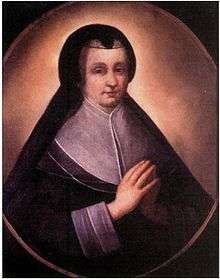Marie-Madeleine de Chauvigny de la Peltrie

Marie-Madeleine de Chauvigny de la Peltrie (1603 – 18 November 1671) was a French woman who started the Order of Ursulines of Quebec.
Life
Marie-Madeleine Chauvigny (also known as: de la Peltrie) was born in 1603 at Alençon, France, the daughter of Guillaume de Chauvigny, Sieur d’Alençon et de Vaubougon, and of Lady Jeanne Du Bouchet. With no male heir, Guillaume de Chauvigny tried to arrange aristocratic matches for his daughters. Marie-Madeleine, the youngest, despite inclination for the cloistered life, found herself obliged to marry the Chevalier de Gruel, Seigneur de La Peltrie. From this marriage, which lasted only five years, there was born one daughter who died in infancy. Widowed at the age of 22, Mme de La Peltrie went into solitary retirement in order to avoid her father’s solicitous attempts to find her a second husband.[1]
Mme de La Peltrie was influenced by the Jesuit Relations to devote her life and fortune to North Amerindian missions.[2] As a result of a serious illness, she made a vow to St. Joseph, promising, in return for her recovery, to go to Canada, to build a house there under his patronage. Upon the death of her father, her relations, thinking her unable to administer her fortune, sought to have her deprived of control over her estate. She appealed to the judicial court of Rouen, won her suit and, as a result, became mistress of her inheritance.[1]
Eager to leave for New France, Mme de La Peltrie went to Paris and consulted M. Vincent de Paul . When she was unable to find space for her baggage on the ships leaving for America, Mme de La Peltrie chartered a vessel at her own expense and loaded it with provisions and furnishings.[1]
She arrived in New France with a number of Ursulines including a future nun, Charlotte Barré (Mother Saint-Ignace) and Marie de l'Incarnation, who was to be the religious founder of the Order of Ursulines. (The order later was called the Ursulines of Quebec). Also part of the passenger list on that voyage was Father Barthélemy Vimont who was the third superior of the Jesuit Mission in Canada, and Father Joseph Poncet.
Her intimacy with Jeanne Mance, Maisonneuve and the other prospective founders of Ville Marie, during the first winter spent near Quebec (1641–42), prompted her to follow them to Montreal, where she was the first communicant at the first Mass celebrated by Father Vimont, S.J. (1642).[3][4] Except for an 18-month absence to help found the utopian colony of Ville-Marie [Montréal] in 1642, she lived cloistered with the nuns she supported.[2] In spite of her entreaties she was never formally admitted to the novitiate, but led the humble and austere life of a true religious, scrupulously following every detail of the observances, and reaching a high degree of contemplative prayer.[3]
Legacy
In 1739 some of the infirmary’s silver pieces, which had belonged in large part to Mme de La Peltrie were given to make a sanctuary lamp. [5]
The Musée des Ursulines de Québec is located in a building just outside the walls of the monastery, on the foundations of the house of the community’s benefactress, Madeleine Chauvigny of Peltrie (1603-1671).[6]
References
- 1 2 3 Chabot, O.S.U., Marie-Emmauel (1979) [1966]. "Chauvigny De La Peltrie, Marie-Madeleine de". In Brown, George Williams. Dictionary of Canadian Biography. I (1000–1700) (online ed.). University of Toronto Press.
- 1 2 Jaenen, Cornelius J., "Marie-Madeleine de Gruel de La Peltrie", The Canadian Encyclopedia Archived 2012-08-06 at the Wayback Machine.
- 1 2

- ↑

- ↑ Lapointe, Gabrielle (1979). "Migeon De Branssat, Marie-Anne, de la Nativité". In Halpenny, Francess G. Dictionary of Canadian Biography. IV (1771–1800) (online ed.). University of Toronto Press.
- ↑ Musee des Ursulines de Quebec
Further reading
External links
- Gaulier, A.B. Madame De La Peltrie, Foundatrice Des Ursulines De Quebec, Alencon, France, 1891
- The Jesuit Relations and Allied Documents, "Travels and Explorations of the Jesuit Missionairies in New France", Thwaites, Reuben Gold ed., Vol.XVI, Chap.2, 'Of the Nuns Recently Arrived in France, and of their Occupation', The Burrows Brothers Company, Cleveland, 1896